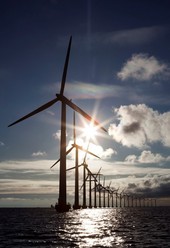
GWEC
As BP continues to search for ways to plug the leak that occurred three weeks ago at the Deepwater Horizon oil rig in the Gulf of Mexico spilling more than three million gallons of crude oil into the ocean, it is becoming more and more clear that the world needs alternative solutions.
Offshore wind power can provide part of the answer to the dilemma of reducing our dependence on finite and polluting fossil fuels. In Europe alone the winds blowing across the seas are an abundant energy source which can be transformed into green electricity that does not emit CO2, and will reduce Europe’s growing dependence on imported fossil fuels, creating thousands of sustainable jobs in the process.
There are currently 830 offshore wind turbines now installed and connected to the grid, totalling 2,063 MW in 39 wind farms in nine European countries. Some 17 offshore wind farms are under construction in Europe, totalling more than 3,500 MW, with just under half being constructed in UK waters. In addition, a further 52 offshore wind farms have won full consent in European waters, totalling more than 16,000 MW, with just over half of this capacity planned in Germany. And the growth rates are impressive: In 2009, the market grew by 54% compared to 2008. In 2010 the market grew by an even more considerable 75% compared to the previous year.
EWEA has a target of reaching 230 GW of wind power by 2020 which will include 40 GW of offshore power. This is a challenging but very feasible goal. By 2030, just ten years later, we envisage some 150 GW of offshore wind power.
If all offshore wind projects in their various stages of planning are added up, there are already some 100 GW of offshore wind projects in addition to existing farms. If these become fully functioning wind farms, they would produce 10% of the EU’s electricity while also avoiding 200 million tonnes of CO2 emissions each year.
Europe must now use the coming decade to prepare for the large-scale exploitation of its biggest indigenous energy resource – offshore wind – overcoming the seemingly significant obstacles – including underwater electricity grids and cables, building the harbours and barges capable of facilitating the installation of offshore wind farms – in the path of its development.
As the US and China are already beginning to show, Europe’s success in offshore wind power can then be repeated the world over.
 Norbert Röttgen, German Federal Environment Minister, has thrown his backing behind developing more offshore wind farms in Germany. Röttgen announced today that offshore companies can rely on debt guarantees from the governemnt to secure the financing of “10 mega projects” in the North and Baltic seas up until the end of 2011.
Norbert Röttgen, German Federal Environment Minister, has thrown his backing behind developing more offshore wind farms in Germany. Röttgen announced today that offshore companies can rely on debt guarantees from the governemnt to secure the financing of “10 mega projects” in the North and Baltic seas up until the end of 2011.






 Comments
Comments
